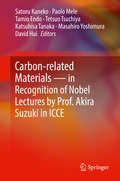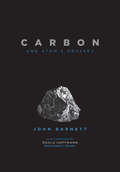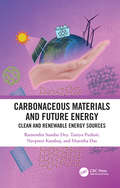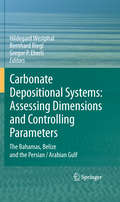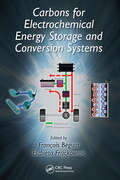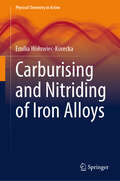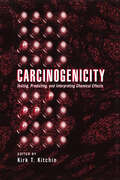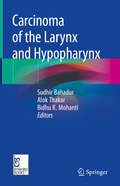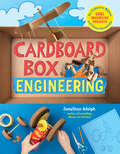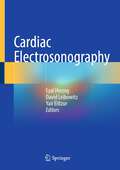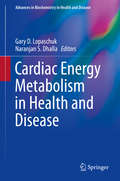- Table View
- List View
Carbon-related Materials in Recognition of Nobel Lectures by Prof. Akira Suzuki in ICCE
by David Hui Paolo Mele Tamio Endo Tetsuo Tsuchiya Satoru Kaneko Katsuhisa Tanaka Masahiro YoshimuraThis book summarizes the recent advances in carbon related materials. It covers both experimental and theoretical approaches in several categories, including such carbon nanomaterial as polymers, carbon nanocomposites, and graphene. It also discusses device applications, as carbon-based materials that have recently received much attention due to their various potential applications. The editors dedicate this book to Nobel Laureate Akira Suzuki for his 85th birthday.
Carbon: A Biography
by Sacha Loeve Bernadette Bensaude-VincentCarbon is much more than a chemical element: it is a polymorphic entity with many faces, at once natural, cultural and social. Ranging across ten million different compounds, carbon has as many personas in nature as it has roles in human life on earth. And yet it rarely makes the headlines as anything other than the villain of our fossil-based economy, feeding an addiction which is driving dangerous levels of consumption and international conflict and which, left unchecked, could lead to our demise as a species. But the impact of CO₂ on climate change only tells part of the story, and to demonize carbon as an element which will bring about the downfall of humanity is to reduce it to a pale shadow of itself. In this major new history of carbon, Bernadette Bensaude-Vincent and Sacha Loeve show that this omnipresent element is at the root of countless histories and adventures through time, thanks to its extraordinary versatility. Carbon has a long and prestigious CV: its work and achievements extend far beyond the burning of fossil fuels. The fourth most abundant element in the universe and the second most abundant element in the human body, carbon is the chemical basis of all known life. Carbon chemistry has a long history, with applications ranging from jewellery to heating, underpinning developments in metallurgy, textiles, pharmaceuticals, electronics, nanoscience and green technologies. A biography of carbon transgresses the boundaries between chemical and social existence, between nature and culture, forcing us to abandon the simplified image of carbon as the anti-hero of human civilization and enabling us to see instead the great diversity of carbon’s modes of existence. With scientific precision and literary flair, Bensaude-Vincent and Loeve unravel the surprising ways in which carbon has shaped our world, showing how unrecognizable the earth would be without it. Uncovering the many hidden lives of carbon allows us to view our own with fresh eyes.
Carbon: Bulk-to-Nano Forms for Detection and Remediation of Environmental Contaminants
by Ajith Manayil Parambil Eepsita Priyadarshini Paulraj RajamaniThis book provides a thorough examination of the diverse applications of carbon-based materials, including both bulk and nano forms, in the detection and remediation of environmental contaminants. The authors aim to meet the growing need for long-term solutions to environmental contamination by emphasizing the adaptability and efficacy of carbon-based materials in a variety of sensing and repair methods. The book opens with an introduction that discusses carbon-based bulk and nanomaterials, highlighting their importance in environmental sensing and remediation, an offering the groundwork for understanding carbon's critical role in tackling modern environmental issues. It then looks into carbon-based sensing techniques, covering various technologies, including electrochemical sensing, fluorescent carbon nanomaterials, colorimetric detection, and surface-enhanced Raman spectroscopy. Each chapter delves into these approaches' principles, benefits, and applications, demonstrating the promise of carbon-based materials in accurately and sensitively detecting environmental contaminants. The book also discusses remediation strategies that use carbon-based materials, including adsorption, catalytic degradation, membrane filtration, and antibacterial activity. These chapters give insights into the mechanisms and effectiveness of carbon material-based methods for removing contaminants from diverse environmental matrices and sustainable approaches to environmental remediation. Furthermore, the book includes case studies and real-world applications demonstrating the practical use of carbon-based sensing and remediation strategies. These case studies demonstrate practical applications of carbon-based materials to solve specific environmental concerns, showing successes and obstacles faced in real-world circumstances.
Carbon: One Atom's Odyssey
by John BarnettA richly illustrated history of a single atom of carbon, tracing its many manifestations from the Big Bang to the present.Carbon: One Atom's Odyssey is an illustrated adaptation of 'Carbon,' a short story from Italian chemist, writer, and Auschwitz survivor Primo Levi. It traces the life story and many molecular manifestations of a single atom of this life-essential element.You'll follow one atom from its spectacular birth 14 billion years ago through its harrowing journey on planet earth where it has become a basic building block of nearly 10 million known compounds in living things. You&’ll learn that carbon: Is breathed in by the Peregrine FalconHelps trees grow strong and tallLets a moth's eye make sense of lightIs found in your pencil as well as in your liverAnd even helps convert grapes into wineIn this wondrous graphic journey, clever narrative and detailed art help bring to life the natural world and teach you a thing or two about how it was created. For anyone with a general interest in chemistry, physics, and the science of the universe, this beautiful book will both educate and inspire. If you&’re ready for a STEAM adventure, then let the journey begin!
Carbon: The Black, the Gray and the Transparent
by Tapan GuptaAll living things contain carbon in some form, as it is the primary component of macromolecules including proteins, lipids, nucleic acids (RNA and DNA), and carbohydrates. As a matter of fact, it is the backbone of all organic (chemistry) compounds forming different kinds of bonds. Carbon: The Black, the Gray and the Transparent is not a complete scientific history of the material, but a book that describes key discoveries about this old faithful element while encouraging broader perspectives and approaches to its research due to its vast applications. All allotropes of carbon are described in this book, along with their properties, uses, and methods of procurement or manufacturing. Black carbon is represented by coal, gray carbon is represented by graphite, and transparent carbon is represented by diamond.
Carbon: The Book of Life
by Paul HawkenA journey into the world of carbon, the most versatile element on the planet, by the New York Times bestselling author Paul HawkenCarbon is the only element that animates the entirety of the living world. Though comprising a tiny fraction of Earth&’s composition, our planet is lifeless without it. Yet it is maligned as the driver of climate change, scorned as an errant element blamed for the possible demise of civilization.Here, Paul Hawken looks at the flow of life through the lens of carbon. Embracing a panoramic view of carbon&’s omnipresence, he explores how this ubiquitous and essential element extends into every aperture of existence and shapes the entire fabric of life. Hawken charts a course across our planetary history, guiding us into the realms of plants, animals, insects, fungi, food, and farms to offer a new narrative for embracing carbon&’s life-giving power and its possibilities for the future of human endeavor.In this stirring, hopeful, and deeply humane book, Hawken illuminates the subtle connections between carbon and our collective human experience and asks us to see nature, carbon, and ourselves as exquisitely intertwined—inseparably connected.
Carbonaceous Materials and Future Energy: Clean and Renewable Energy Sources
by Ramendra Sundar Dey Taniya Purkait Navpreet Kamboj Manisha DasModern lifestyle demands consistent supply of energy for our daily need and comfort. To encounter global demands for energy and to permit for diminution of fossil fuels, there is an urgent need for efficient, sustainable and clean energy sources. Carbonaceous material such as graphene, carbon nanotubes, fullerenes, mesoporous carbon, carbon nanofibres and their composites are extensively studied material. They are playing important role to alternative clean energy sources. This book reviews the roadmap of various form of carbonaceous materials used in several energy devices and provides guideline of future perspective.
Carbonate Depositional Systems: The Bahamas, Belize and the Persian/Arabian Gulf
by Bernhard M. Riegl Gregor P. Eberli Hildegard WestphalCarbonate sediments are of increasing relevance for archives of past environmental conditions and for economical reasons in areas of geothermal energy and hydrocarbon reservoirs. Complex interaction of physical and chemical parameters with biological parameters determines the architecture and composition of carbonate sedimentary bodies. This book closes some of the still existing gaps in our understanding of the influence and interplay of physical, chemical, and biological parameters with carbonate sedimentation. An understanding of this interaction is not only required for reliable prediction of reservoir quality but also for a robust interpretation of environmental conditions in the past and the present. It is written by geologists for geologists in order to provide an easily accessible overview of the large amount of relevant information provided by the neighbouring sciences. The approach of the book is to document the modern depositional environments of three classical areas of carbonate deposition, each characteristic for a specific sedimentological setting (isolated platform, attached shelf, ramp) in order to assess both the range of physical, biological and chemical parameters and their sedimentary response. This book presents a comprehensive compilation based on data from published work and unpublished theses, and the integration of these data in order to extract previously undiscovered relationships between the discussed parameters and carbonate deposition.
Carbonate Reservoir Rocks
by Ksenia I. BagrintsevaMost of the world's energy still comes from fossil fuels, and there are still many strides being made in the efficiency and cost effectiveness of extracting these important and increasingly more elusive natural resources. This is only possible if the nature of the emergence, evolution, and parameter estimation of high grade reservoir rocks at great depths is known and a theory of their forecast is developed. Over 60 percent of world oil production is currently associated with carbonate reservoir rocks. The exploration, appraisal and development of these fields are significantly complicated by a number of factors. These factors include the structural complexity of the carbonate complexes, variability of the reservoir rock types and properties within a particular deposit, many unknowns in the evaluation of fracturing and its spatial variability, and the preservation of the reservoir rock qualities with depth. The main objective of most studies is discovering patterns in the reservoir rock property changes of carbonate deposits of different genesis, composition and age. A short list of the unsolved issues includes: the role of facies environment in the carbonate formation; the major geologic factors affecting the formation of high-capacity reservoir rocks and preservation of their properties; recommendations as to the use of the new techniques in studies of the structural parameters; and establishing a correlation between the major evaluation parameters. The focus of this volume is to show the scientific and engineering community a revolutionary process. The author perfected an earlier developed methodology in studies of the void space structure (Bagrintseva's method, 1982). This methodology is based on carbonate rock saturation with luminophore and on special techniques in processing of photographs made under UV light. The luminophore technique was combined with the raster electron microscopy and its variation, the studies under the cathode luminescence regime. This combination enabled a more detailed study of the reservoir void space, the nonuniformity in the open fracture evolution, their morphology, length and variability of openness. Over recent years these techniques have found wide application. Useful for the veteran engineer or scientist and the student alike, this book is a must-have for any geologist, engineer, or student working in the field of upstream petroleum engineering.
Carbonic Anhydrase as Drug Target: Thermodynamics and Structure of Inhibitor Binding
by Daumantas MatulisThis book offers deep insights into the thermodynamics and molecular structures of the twelve catalytically active isoforms of human carbonic anhydrase (CA) with a particular focus on inhibitor binding for drug design. X-ray crystallographic structures in combination with enzyme kinetic testing provide information on the interaction of CAs and their inhibitors, knowledge which is crucial for rational drug design. CAs are zinc carrying enzymes that catalyse the reversible interconversion of carbon dioxide and bicarbonate and are involved in numerous cellular processes. They are therefore a common target for drugs. The suppression of CA activities through inhibitory compounds has found application for example in diuretics and in glaucoma therapy. In this book methods used to determine binding thermodynamics of inhibitory compounds (Isothermal titration calorimetry, Fluorescent thermal shift assay/differential scanning fluorimetry and others) will be compared in detail. Also types and chemical synthesis of CA inhibitors, the use of antibodies against CAs as well as inhibitor application in animals are discussed.
Carbonic Anhydrase: Its Inhibitors and Activators
by Claudiu T. Supuran Andrea Scozzafava Janet ConwayCarbonic Anhydrase: Its Inhibitors and Activators provides a state-of-the-art overview of the latest developments and challenges in carbonic anhydrase research. Authors describe the mechanisms of action of specific inhibitors in relation to physiological function, and present previously unpublished research on CA activators. Written by a team of in
Carbonic Anhydrase: Mechanism, Regulation, Links To Disease, And Industrial Applications (Subcellular Biochemistry #75)
by Susan C. Frost Robert MckennaThe study of carbonic anhydrase has spanned multiple generations of scientists. Carbonic anhydrase was first discovered in 1932 by Meldrum and Roughton. Inhibition by sulfanilamide was shown in 1940 by Mann and Keilin. Even Hans Krebs contributed to early studies with a paper in 1948 showing the relationship of 25 different sulfonamides to CA inhibition. It was he who pointed out the importance of both the charged and uncharged character of these compounds for physiological experiments. The field of study that focuses on carbonic anhydrase (CA) has exploded in recent years with the identification of new families and isoforms. The CAs are metalloenzymes which are comprised of 5 structurally different families: the alpha, beta, gamma, and delta, and epsilon classes. The alpha class is found primarily in animals with several isoforms associated with human disease. The beta CAs are expressed primarily in plants and are the most divergent. The gamma CAs are the most ancient. These are structurally related to the beta CAs, but have a mechanism more similar to the alpha CAs. The delta CAs are found in marine algae and diflagellates. The epsilon class is found in prokaryotes in which it is part of the carboxysome shell perhaps supplying RuBisCO with CO2 for carbon fixation. With the excitement surrounding the discovery of disease-related CAs, scientists have redoubled their efforts to better understand structure-function relationships, to design high affinity, isotype-specific inhibitors, and to delineate signaling systems that play regulatory roles over expression and activity. We have designed the book to cover basic information of mechanism, structure, and function of the CA families. The authors included in this book bring to light the newest data with regard to the role of CA in physiology and pathology, across phylums, and in unique environmental niches.
Carboniferous Giants and Mass Extinction: The Late Paleozoic Ice Age World
by George McGhee Jr.Picture a world of dog-sized scorpions and millipedes as long as a car; tropical rainforests with trees towering over 150 feet into the sky and a giant polar continent five times larger than Antarctica. That world was not imaginary; it was the earth more than 300 million years ago in the Carboniferous period of the Paleozoic era. In Carboniferous Giants and Mass Extinction, George R. McGhee Jr. explores that ancient world, explaining its origins; its downfall in the end-Permian mass extinction, the greatest biodiversity crisis to occur since the evolution of animal life on Earth; and how its legacies still affect us today.McGhee investigates the consequences of the Late Paleozoic ice age in this comprehensive portrait of the effects of ancient climate change on global ecology. Carboniferous Giants and Mass Extinction examines the climatic conditions that allowed for the evolution of gigantic animals and the formation of the largest tropical rainforests ever to exist, which in time turned into the coal that made the industrial revolution possible—and fuels the engine of contemporary anthropogenic climate change. Exploring the strange and fascinating flora and fauna of the Late Paleozoic ice age world, McGhee focuses his analysis on the forces that brought this world to an abrupt and violent end. Synthesizing decades of research and new discoveries, this comprehensive book provides a wealth of insights into past and present extinction events and climate change.
Carbons for Electrochemical Energy Storage and Conversion Systems
by Elzbieta Frackowiak François BéguinAs carbons are widely used in energy storage and conversion systems, there is a rapidly growing need for an updated book that describes their physical, chemical, and electrochemical properties. Edited by those responsible for initiating the most progressive conference on Carbon for Energy Storage and Environment Protection (CESEP), this book undoub
Carbonyl Compounds: Reactants, Catalysts and Products
by Feng Shi Hongli Wang Xingchao DaiCarbonyl Compounds Discover how carbonyl compounds bridge reactants, catalysts, and specific products Carbonyl-containing molecules represent some of the most versatile functionalities in organic chemistry, with applications in a wide variety of areas. In Carbonyl Compounds: Reactants, Catalysts and Products, accomplished chemists and authors Feng Shi, Hongli Wang, and Xingchao Dai deliver a comprehensive treatment of these multi-functional compounds. You’ll discover how to build carbonyl molecules with traditional and non-traditional methods, how to transform carbonyl-containing molecules into fine chemicals, and how to use carbonyl-containing molecules as catalytic materials for the synthesis of fine chemicals. The book is a comprehensive and systematic treatment of carbonyl compounds as reactants, catalysts, and products. From the use of carbon monoxide in the hydroformylation of alkenes and alkynes to the reactions via carbonyl and hydroxyl groups recycling, you’ll find everything you need to know about these versatile compounds. Readers will also benefit from the inclusion of: A thorough introduction to carbonyl molecules as reactants, including treatments of carbon monoxide, carbon dioxide, HCHO, HCOOH, and CO surrogates An exploration of carbonyl compounds as catalysts, including acid catalyzed reactions with -CO2H and reactions via carbonyl and hydroxyl groups recycling A practical discussion of the synthetic applications of carbonyl compounds, including the synthesis of functional molecules and the synthesis of functional materials A concise treatment of future perspectives and potential research trends for carbonyl molecules Perfect for organic, catalytic, pharmaceutical, and physical chemists, Carbonyl Compounds will also earn a place in the libraries of chemical engineers and materials scientists seeking a one-stop reference for up-to-date information about the building, transformation, and applications of carbonyl-containing molecules.
Carburising and Nitriding of Iron Alloys (Physical Chemistry in Action)
by Emilia Wołowiec-KoreckaThis monograph is a comprehensive exploration of the thermochemical treatment of iron alloys, focusing specifically on quenching, carburising, and nitriding. The book introduces the importance of materials engineering in the context of contemporary societal needs and delves into the historical development of thermochemical treatment over the centuries. The global challenges facing thermochemical treatment are also outlined while the three primary development trends identified in the literature at the beginning of the 21st century: reducing thermal deformation in mass production, process modelling, and a multifactorial reduction of treatment costs are also reviewed. Finally, a detailed discussion on the significance of computational methods in advancing thermochemical treatment is included. The book provides a detailed examination of thermochemical treatment processes and their evolution and is a useful tool for graduates, researchers, and professionals working in the area of materials engineering.
Carcinogenicity: Testing: Predicting, and Interpreting Chemical Effects
by Kirk T. KitchinOffers comprehensive coverage of currently available cancer predictors, the most recent research on carcinogenicity, and the design and interpretation of carcinogenicity experiments. Presents mouse, rat, and human carcinogenicity data for the liver, kidney, breast, cervix, prostate, hematopoietic system, colon, skin, urinary bladder, mouth, stomach, thyroid, and pancreas.
Carcinoma of the Larynx and Hypopharynx
by Sudhir Bahadur Alok Thakar Bidhu K. MohantiCarcinomas of the larynx and hypopharynx present unique challenges when it comes to their assessment and management. Management involves the essential dilemma of optimizing cure rates while also ensuring that potential disability due to compromised airway, voice and swallowing is minimized. Treatment decisions involve careful disease assessment, judicious multispecialty decision-making, and subsequent meticulous implementation of the selected treatment modalities.The critical nature of each of these steps has led to dramatic advances in assessment techniques (radiology, endoscopy and photography, stroboscopy, narrow band imaging, contact endoscopy) and also in treatment methods (radiation therapy, combined concurrent chemo-radiation, combined sequential chemo-radiation, trans-oral CO2 laser and robotic surgery, partial laryngectomy, total laryngectomy, extended total laryngectomy). As such, treatment decisions have become increasingly complex with the twin objectives of maximizing cure as well as function preservation and are based on tumor stage, tumor location, systemic co-morbidities, nutritional status, patient priorities, and social and economic factors. This multidisciplinary book has been written by a team of editors with considerable experience and expertise in these critical areas and a deep understanding of teamwork and the strengths and limitations of individual technologies and treatments. It presents a homogeneous and unbiased view that is applicable to all specialties involved in the care of larynx and hypopharynx cancers.
Cardamom: The Genus Elettaria (Medicinal And Aromatic Plants - Industrial Profiles Ser. #Vol. 30)
by P. N. Ravindran K. J. MadhusoodananCardamom otherwise known as Malabar cardamom, true cardamom or small cardamom second only to pepper in its importance during the Renaissance period, is often qualified as the Queen of Spices because of its very pleasant aroma and taste. The Western Ghat forest of the Malabar coast, India, is the center of origin and diversity for cardamom and it mi
Cardboard Box Engineering: Cool, Inventive Projects for Tinkerers, Makers & Future Scientists
by Jonathan AdolphCardboard is everywhere! For creative kids aged 9 to 14, it&’s the perfect eco-friendly building material, and Cardboard Box Engineering is the perfect guide to get them started on inventive tinkering. A working kaleidoscope, a marble roller coaster, a robotic hand, and a wind-powered tractor with cardboard gears are just some of the ingenious projects developed by Jonathan Adolph, author of the best-selling Mason Jar Science. Working with simple household tools, kids can follow the step-by-step photographic instructions to exercise their design smarts, expand their 3-D thinking, and learn the basics of physics and engineering with activities that have real-life applications.
Cardiac Adaptations: Molecular Mechanisms (Advances in Biochemistry in Health and Disease #4)
by Bohuslav Ostadal Naranjan S. DhallaThis book summarizes present knowledge of different mechanisms involved in the development of positive and negative consequences of cardiac adaptation. Particular attention is paid to the still underestimated adaptive cardiac responses during development, to adaptation to the frequently occurring pressure and volume overload as well as to cardiac changes, induced by enduring exercise and chronic hypoxia. Cardiac Adaptations will be of great value to cardiovascular investigators, who will find this book highly useful in their cardiovascular studies for finding solutions in diverse pathological conditions; it will also appeal to students, fellows, scientists, and clinicians interested in cardiovascular abnormalities.
Cardiac CT Imaging: Diagnosis of Cardiovascular Disease
by Matthew J. Budoff Jerold S. ShinbaneCT is an accurate technique for assessing cardiac structure and function, but advances in computing power and scanning technology have resulted in increased popularity. It is useful in evaluating the myocardium, coronary arteries, pulmonary veins, thoracic aorta, pericardium, and cardiac masses; because of this and the speed at which scans can be performed, CT is even more attractive as a cost-effective and integral part of patient evaluation. This book collates all the current knowledge of cardiac CT and presents it in a clinically relevant and practical format appropriate for both cardiologists and radiologists. The images have been supplied by an experienced set of contributing authors and represent the full spectrum of cardiac CT. As increasing numbers have access to cardiac CT scanners, this book provides all the relevant information on this modality. This is an extensive update of the previous edition bringing the reader up-to-date with the immense amount of updated content in the discipline.
Cardiac Cytoarchitecture: How to Maintain a Working Heart
by Elisabeth EhlerThis book presents a collection of expert reviews on different subcellular compartments of the cardiomyocyte, addressing fundamental questions such as how these compartments are assembled during development, how they are changed in and by disease and which signaling pathways have been implicated in these processes so far. As such, it offers the first overview of the cell biology of heart disease of its kind, addressing the needs of cell biology students specializing in vascular and cardiac biology, as well as those of cardiologists and researchers in the field of cell biology.
Cardiac Electrosonography
by David Leibowitz Eyal Herzog Yair ElitzurThis book focuses on a new clinical algorithmic approach to acute patient care based on the combination of electrocardiography (ECG) and echocardiography performance and interpretation, now renamed: ECG-sonography or electrosonography. The combination of these two basic skills improves patient management by healthcare providers in the acute setting. ECG is one of the oldest diagnostic tools in evaluating patients with cardiovascular symptoms and multiple and complex criteria for its interpretation have been developed over the past decades. The use of point of care ultrasound based on handheld echocardiography has recently emerged as an important clinical tool, particularly in the emergency department (ED) and intensive care unit. These studies are mainly performed by non-cardiologists including intensivists and ED physicians in addition to the physical exam and standard diagnostic tests such as the chest X-ray and laboratory tests to evaluate patients quickly and efficiently.Cardiac Electrosonography provides a new algorithmic approach to ECG interpretation and a simple tutorial of echocardiography performance and interpretation with a major focus on handheld echocardiography. It includes representative cases of patients presenting to the ED with a specific, acute cardiovascular symptom and demonstrates appropriate use of both ECG and echocardiography to improve patient management and outcome. It therefore represents an essential guide to this hybrid procedure for all practicing and trainee cardiologists and all healthcare professionals who manage these patients.
Cardiac Energy Metabolism in Health and Disease (Advances in Biochemistry in Health and Disease #11)
by Naranjan S. Dhalla Gary D. LopaschukThe heart has a very high energy demand but very little energy reserves. In order to sustain contractile function, the heart has to continually produce a large amount of ATP The heart utilizes free fatty acids mainly and carbohydrates to some extent as substrates for making energy and any change in this energy supply can seriously compromise cardiac function It has emerged that alterations in cardiac energy metabolism are a major contributor to the development of a number of different forms of heart disease It is also now known that optimizing energy metabolism in the heart is a viable and important approach to treating various forms of heart disease. Cardiac Energy Metabolism in Health and Disease describes the research advances that have been made in understanding what controls cardiac energy metabolism at molecular, transcriptional and physiological levels It also describes how alterations in energy metabolism contribute to the development of heart dysfunction and how optimization of energy metabolism can be used to treat heart disease The topics covered include a discussion of the effects of myocardial ischemia, diabetes, obesity, hypertrophy, heart failure, and genetic disorders of mitochondrial oxidative metabolism on cardiac energetics The treatment of heart disease by optimizing energy metabolism is also discussed, which includes increasing overall energy production as well as increasing the efficiency of energy production and switching energy substrate preference of the heart. This book will be a valuable source of information to graduate students, postdoctoral fellows, and investigators in the field of experimental cardiology as well as biochemists, physiologists, pharmacologists, cardiologists, cardiovascular surgeons and other health professionals.
